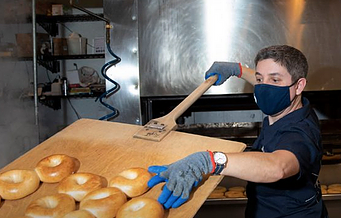By Lawrence Grown

Imagine yourself in another town, full of chain stores and strip malls. What are the forces that grow one type of city or another? Zoning is certainly a major factor. Another is response to the desires of the locals. What kinds of companies do the residents support? What types of businesses do you want to see thriving in Berkeley?
While you’re out celebrating our Nation’s Independence, celebrate our local independents too! This article is about Berkeley’s independent businesses, the institutional structures that support them, and the promotions they create.
Berkeley has always had an independent spirit, the free-thinking drive to do things differently. Berkeley is known across the world for starting powerful trends like the Free Speech Movement, the disability rights movement, and the California Cuisine/Farm-to-table movement. Berkeley was the first city to have a curbside recycling program, a polystyrene/styrofoam ban, and a soda tax. The spirit behind these initiatives permeates the business community today. Berkeley has a plethora of thought leaders and unique local businesses you won’t find anywhere else.
Beginning around 2001, a national trend sprung up to support local businesses. Organizations such as AMIBA, Main Street Alliance, and BALLE/Common Future helped foster small organizations across the country, and campaigns such as Shop Indie Local. Events like Plaid Friday, Small Business Saturday, Cider Monday, Independents Week, and Manufacturing Week, along with our own Buy Local Berkeley, grew out of this movement.
You might want to know how a business gets started here. Berkeley, in fact, has a robust support network for small businesses, starting with the City’s Office of Economic Development. The OED makes Berkeley more welcoming by helping small business owners access financing, talent, data, and technical assistance. They support business groups such as the Berkeley Chamber of Commerce, Visit Berkeley, business improvement districts (BIDs), and volunteer-run business networks, to promote connections and growth opportunities. In fact, OED has catalyzed or supported many of the initiatives in this article.
The Berkeley Chamber of Commerce promotes business networking, leadership, education, and sales. Not to be conflated with the conservative National Chamber of Commerce, the Berkeley Chamber is an independent progressive membership organization. Hopefully you have already purchased some local favorite wines, cookies, and crafts at their annual Holiday Gift Fair or shopped from the #BerkeleyHolidays gift guide. If not, this is a great year to start!
If you check into a hotel room in town, a Berkeley Visitor Guide will suggest places to eat, shop, or be entertained. The guides are produced by Visit Berkeley, our tourist bureau. The Visit Berkeley website is also packed with useful information for visitors and local residents alike. You may have recently enjoyed a mouth-watering meal during Berkeley Restaurant Week, and you will now find a multitude of refreshing beverages (alcoholic and non-alcoholic) from one of many businesses currently participating in JULYbations!
What’s been Discovered in Berkeley? The city began the #Discovered In Berkeley campaign to spotlight local businesses enriching our community and building a better world. A few recently-featured businesses that illustrate sustainability, community, and innovation include Metro Lighting, All Power Labs, and Urban Ore. Discovered in Berkeley was developed by Celery Design Collaborative and OED.
Have you biked down the center of Shattuck Avenue during Sunday Streets? Enjoyed a pastry and Berkeley High Jazz at the Solano Stroll? Discovered new painters or “pinos” at the Gilman Art Walk? Merchants associations put on these events to attract visitors and create excitement.
Berkeley commercial districts such as Telegraph Avenue, Downtown Berkeley, the Elmwood, and Solano Avenue raise money through property taxes, paid either by property owners or by commercial tenants. Others, such as the Gilman District, and Lorin District are volunteer organizations, and Fourth Street is a hybrid. Though budgets and resources vary dramatically, all attract visitors through campaigns and events.

The Bay Area Organization of Black Owned Businesses (BAOBOB) provides a wonderful resource for Black-owned businesses – and ways for the community to support them through the BAOBOB app. West Berkeley Artists and Industrial Companies (WEBAIC) is an advocacy group, working to keep West Berkeley’s industrial spaces available and affordable to makers and manufacturers.
Where can you find locally-owned businesses in design and construction? The West Berkeley Design Loop, of course! Their mission is to promote Berkeley, and West Berkeley specifically, as the premier design destination for the greater Bay Area. Berkeley-Built magazine also grew out of the Design Loop.
Most of these groups meet regularly through the Berkeley Business District Network (BBDN), convened by OED for district leaders to keep each other informed, and to foster collaboration. When districts are thriving, individual businesses thrive too, and shoppers have a better experience.
Why shop at big box stores when you can support local small business owners, employees, and ideas? Statistically, of every $100 spent at independent Berkeley stores, $68 stays in the community. For example, when you buy from The Gardener, local owners, employees, and artisans might spend those dollars on groceries from Berkeley Bowl or a metalworking book from Builders Booksource. And that money might pay for a slice of pizza from the Cheese Board, or tickets to a show at the Berkeley Rep, continuing the cycle. But when you buy online, very little (if any) of that money gets circulated in Berkeley.
Make this Independence Day an “Independents” Day by supporting local businesses. Berkeley businesses are your neighbors. They have deep knowledge you aren’t likely to find at chain stores. Supporting them builds a more resilient, more vibrant, more interesting local economy. Thank you for contributing to our community!



















Comentários